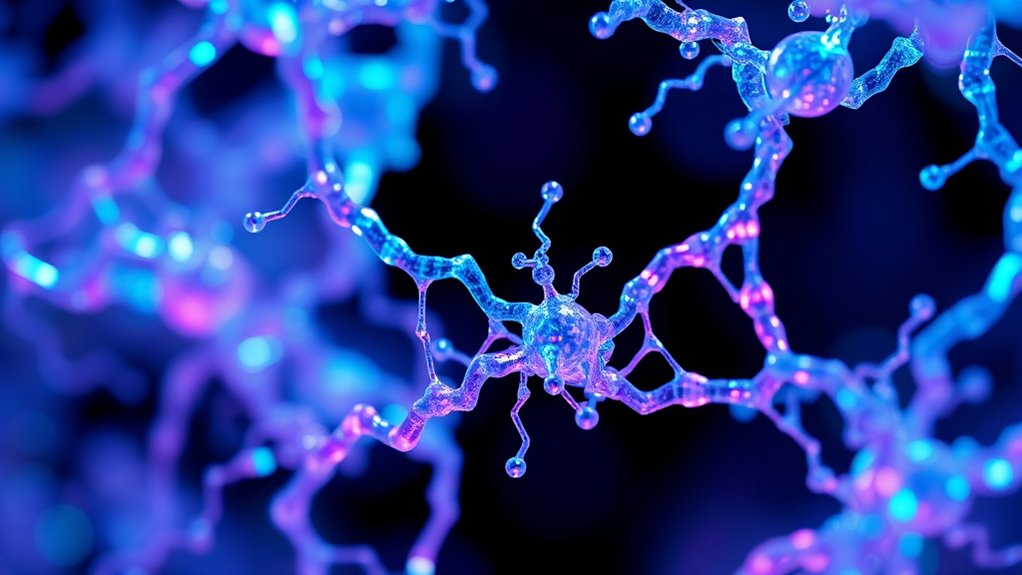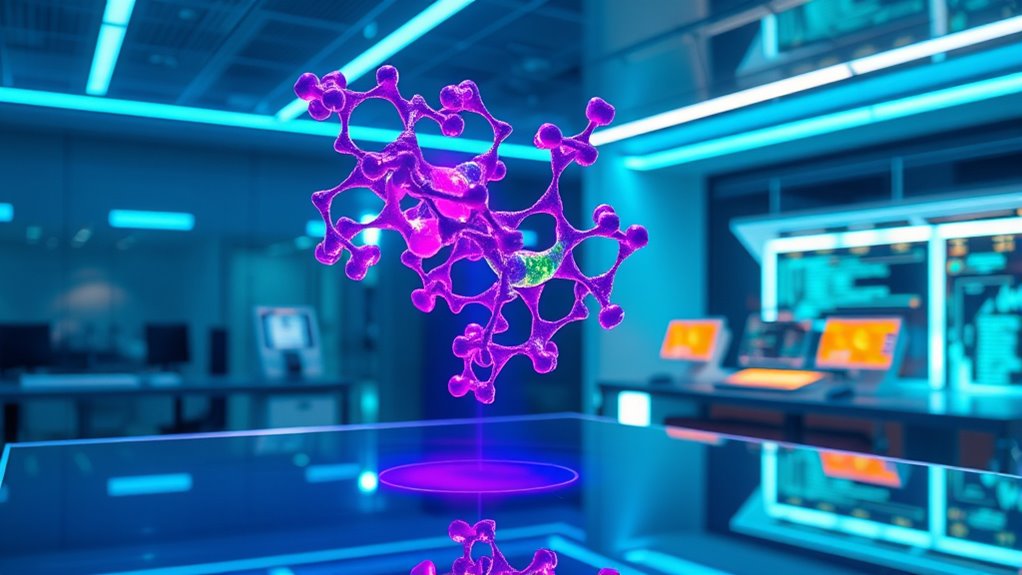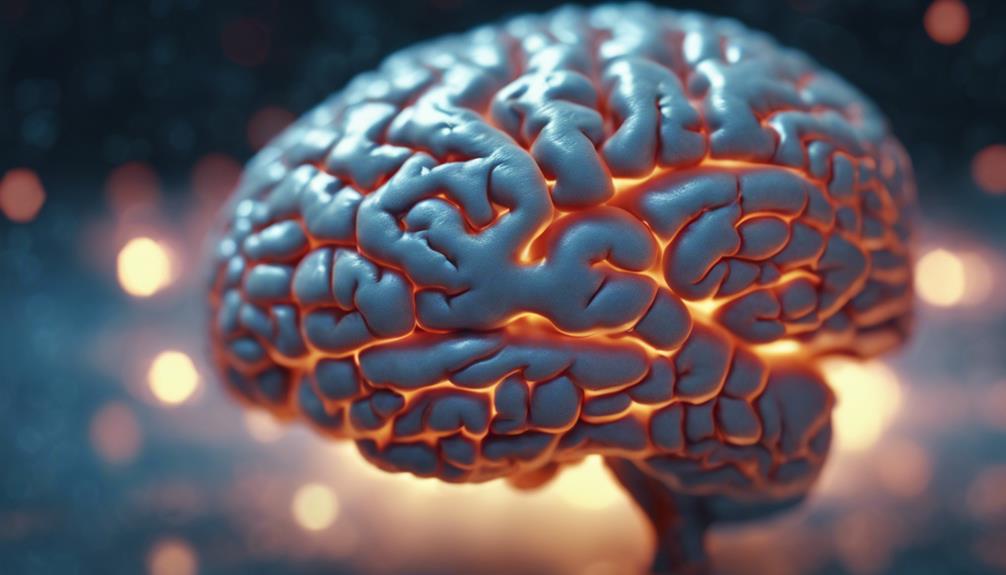AI-generated proteins are transforming drug discovery by allowing you to design and predict new proteins quickly and accurately. You can model complex folding patterns, target specific traits, and create proteins tailored for various applications—all without extensive lab work. This approach dramatically shortens development times and opens new possibilities for treating diseases. If you want to explore how this cutting-edge technology will shape the future, there’s more to uncover ahead.
Key Takeaways
- AI accelerates protein design, enabling rapid creation of novel therapeutics and reducing development timelines significantly.
- Machine learning models analyze large datasets to predict protein structures, functions, and interactions with high accuracy.
- Computational modeling allows tailored protein structures with desired traits like stability and enzymatic activity.
- AI-driven protein discovery opens new avenues for targeting previously undruggable molecules and expanding biotech applications.
- The integration of AI and expert knowledge is transforming drug discovery into a faster, more precise, and innovative process.

Artificial intelligence is revolutionizing how scientists design and discover new proteins, opening doors to therapies and materials once thought impossible. At the heart of this breakthrough is protein design, a complex process that involves creating novel proteins with specific functions. Traditionally, this task relied heavily on trial-and-error experiments, which could be time-consuming and costly. Now, with AI-powered computational modeling, you can predict how proteins will fold, interact, and perform before ever synthesizing them in the lab. This shift allows you to streamline the discovery process, reducing development timelines from years to months or even weeks.
AI accelerates protein discovery, cutting development from years to weeks.
When using AI for protein design, computational modeling becomes your most valuable tool. It enables you to simulate the intricate folding patterns of amino acid chains, revealing the most promising candidates for therapeutic or industrial applications. Instead of relying solely on intuition or random screening, you can input desired characteristics—like stability, binding affinity, or enzymatic activity—and let AI algorithms generate potential protein structures that meet these criteria. This targeted approach not only accelerates discovery but also enhances your ability to tailor proteins for specific uses, whether it’s fighting diseases or creating sustainable materials. Additionally, leveraging machine learning models can help identify novel structural motifs that might not be apparent through traditional methods. Incorporating predictive analytics into your workflow further improves the efficiency and accuracy of your designs. Moreover, understanding the scientific principles behind protein folding can deepen your insights and improve model accuracy.
As you harness AI-driven computational modeling, you’re empowered to explore vast protein space more efficiently than ever before. Machine learning models analyze immense datasets of known protein structures to identify patterns and relationships, helping you predict how new sequences might behave. These models continuously improve as they learn from new data, increasing the accuracy of your predictions over time. With this capability, you can design proteins with unprecedented precision, minimizing costly laboratory experiments and focusing resources on the most promising candidates. Additionally, integrating advanced data analysis techniques can further refine your results by uncovering subtle insights within complex datasets.
Moreover, AI-generated proteins open up new possibilities in drug discovery. You can design novel enzymes that target previously undruggable molecules or develop proteins with enhanced stability for use in harsh environments. This technological leap means you’re not limited by existing natural proteins but can instead craft entirely new ones, expanding the scope of what’s achievable in medicine and biotechnology. Additionally, integrating Gold IRA strategies into biotech investments could diversify funding sources for innovative research, ensuring sustainable development of these advanced therapies. By integrating AI into your protein design workflow, you’re not just speeding up discovery—you’re fundamentally transforming how new proteins are created, making previously impossible innovations within reach.
In essence, AI-powered computational modeling is your gateway to a new era of protein design. It empowers you to predict, create, and optimize proteins with unmatched speed and accuracy. As you continue to explore this frontier, you’ll find that the combination of artificial intelligence and your expertise can unleash solutions to some of the most pressing challenges in health, industry, and beyond.
Frequently Asked Questions
How Do Ai-Designed Proteins Compare to Naturally Occurring Ones?
You might wonder how AI-designed proteins compare to natural ones. AI-designed proteins can achieve impressive protein stability and exhibit diverse functions, sometimes surpassing natural proteins in specific tasks. They are tailored for particular interactions, offering high precision. However, natural proteins have evolved for ideal stability and functional diversity over millions of years. While AI-designed proteins are promising, ongoing research continues to evaluate their long-term stability and versatility compared to their natural counterparts.
What Are the Ethical Considerations of Ai-Generated Proteins?
You should consider ethical issues like intellectual property rights and biosafety when working with AI-generated proteins. There’s a risk of patent disputes over novel designs, and you must guarantee these proteins don’t pose safety threats to humans or the environment. Responsible use involves clear ownership rules and rigorous safety testing to prevent misuse or unintended consequences, safeguarding both innovation and public health.
Can AI Predict Potential Side Effects of Novel Proteins?
You might think AI can’t predict side effects accurately, but its predictive accuracy is improving. AI analyzes vast data to identify potential safety concerns early, aiding safety assessments for novel proteins. While it doesn’t replace clinical trials, AI helps flag risks sooner, reducing surprises later. Relying on AI enhances your ability to evaluate safety, making drug development more efficient and safer for future therapies.
How Scalable Is AI Protein Design for Industrial Applications?
You might wonder how scalable AI protein design is for industrial use. While it shows promise, scalability challenges and manufacturing hurdles remain. You’ll need robust processes to produce large quantities reliably, and quality control becomes more complex at scale. Advances are ongoing, but overcoming these hurdles is essential before AI-designed proteins can be widely adopted in industry. Overall, with continued development, scalability is likely to improve considerably.
What Regulatory Hurdles Exist for Ai-Created Protein Therapeutics?
You should know that regulatory hurdles for AI-created protein therapeutics are complex. Only about 30% of new drugs gain approval on their first attempt, highlighting challenges. International regulation and intellectual property issues are major concerns, as laws haven’t fully caught up with AI innovations. You’ll need to navigate varying standards across countries, ensuring your AI-designed proteins meet safety, efficacy, and patent requirements to succeed in global markets.
Conclusion
You might think AI-generated proteins are just a futuristic idea, but they’re already transforming drug discovery. By rapidly designing novel proteins, AI accelerates development and reduces costs. Some worry about reliability, but with ongoing validation and improvements, these proteins are becoming increasingly dependable. Embracing this technology means you can stay ahead in medicine’s evolution, opening treatments that were once impossible. The future of drug discovery is here, and AI-generated proteins are leading the way—don’t miss out.
Amina brings over a decade of journalism experience to her role as Editor-in-Chief. Under her leadership, Exquisite Post has flourished, maintaining the highest standards of integrity and excellence. Amina’s commitment to truth and her visionary approach guide the editorial team in producing impactful news stories that resonate with our audience.










